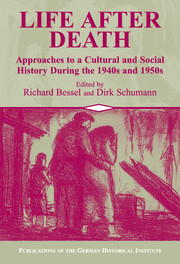Book contents
- Frontmatter
- Introduction Violence, Normality, and the Construction of Postwar Europe
- 1 Post-Traumatic Stress Disorder and World War II
- 2 Between Pain and Silence
- 3 Paths of Normalization after the Persecution of the Jews
- 4 Trauma, Memory, and Motherhood
- 5 Memory and the Narrative of Rape in Budapest and Vienna in 1945
- 6 “Going Home”
- 7 Desperately Seeking Normality
- 8 Family Life and “Normality” in Postwar British Culture
- 9 Continuities and Discontinuities of Consumer Mentality in West Germany in the 1950s
- 10 “Strengthened and Purified Through Ordeal by Fire”
- 11 The Nationalization of Victimhood
- 12 Italy after Fascism
- 13 The Politics of Post-Fascist Aesthetics
- 14 Dissonance, Normality, and the Historical Method
- Index
5 - Memory and the Narrative of Rape in Budapest and Vienna in 1945
Published online by Cambridge University Press: 05 January 2013
- Frontmatter
- Introduction Violence, Normality, and the Construction of Postwar Europe
- 1 Post-Traumatic Stress Disorder and World War II
- 2 Between Pain and Silence
- 3 Paths of Normalization after the Persecution of the Jews
- 4 Trauma, Memory, and Motherhood
- 5 Memory and the Narrative of Rape in Budapest and Vienna in 1945
- 6 “Going Home”
- 7 Desperately Seeking Normality
- 8 Family Life and “Normality” in Postwar British Culture
- 9 Continuities and Discontinuities of Consumer Mentality in West Germany in the 1950s
- 10 “Strengthened and Purified Through Ordeal by Fire”
- 11 The Nationalization of Victimhood
- 12 Italy after Fascism
- 13 The Politics of Post-Fascist Aesthetics
- 14 Dissonance, Normality, and the Historical Method
- Index
Summary
In an exhibition in Vienna on Austrian women's lives in 1945 there hung a remarkable picture taken in the Prater in January 1946. It was a photo of a sixteen-year-old girl who was raped and killed by five Russian soldiers, as stated in the police record. The picture is lyrical; even in death her face remains peaceful. Her dress is loose but explicitly suggests sexual violence. The blood on her face is not disturbing. Her hands are gracefully placed. The twisted body resembles both that of Christ being removed from the Cross and the famous picture of the half-naked Zoia Kosmonievskaja, the Soviet Saint. Her body also melts smoothly into the background.
This picture disturbed me. Why exactly was this picture chosen for exhibition from the hundreds of other police photos with less aesthetic but more criminal attributes? It gave a face to the millions of women who died during the so-called peacetime. The photo also radiates a certain peaceful aspect of the victimization of that girl. This led me to do a comparative study of the rape cases of 1945 in Budapest and in Vienna.
Both cities were liberated by the Red Army after heavy fighting. Soviet troops were stationed in Vienna until 1955, but historical and political discourse on the Second World War in these two countries was separated by the Iron Curtain and focused on differences while ignoring obvious similarities. That is the reason why analyzing a single historical event (rapes committed by the soldiers of the Red Army) and the ways in which this event was discussed or suppressed in the national historiographies of the two countries might enrich our understanding of violence in the Second World War. I have relied very much on the work of Austrian historians when asking similar questions in my interviews in Budapest in order to produce comparative data.
- Type
- Chapter
- Information
- Life after DeathApproaches to a Cultural and Social History of Europe During the 1940s and 1950s, pp. 129 - 148Publisher: Cambridge University PressPrint publication year: 2003
- 5
- Cited by



